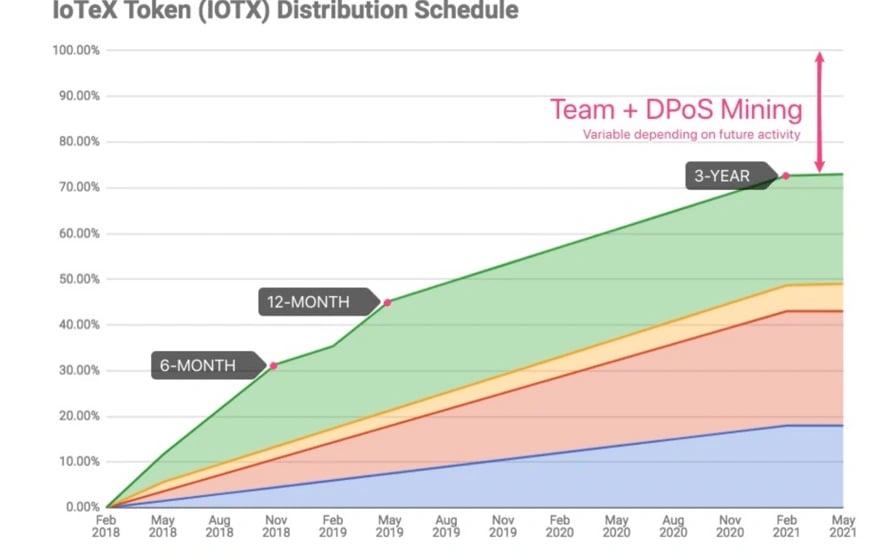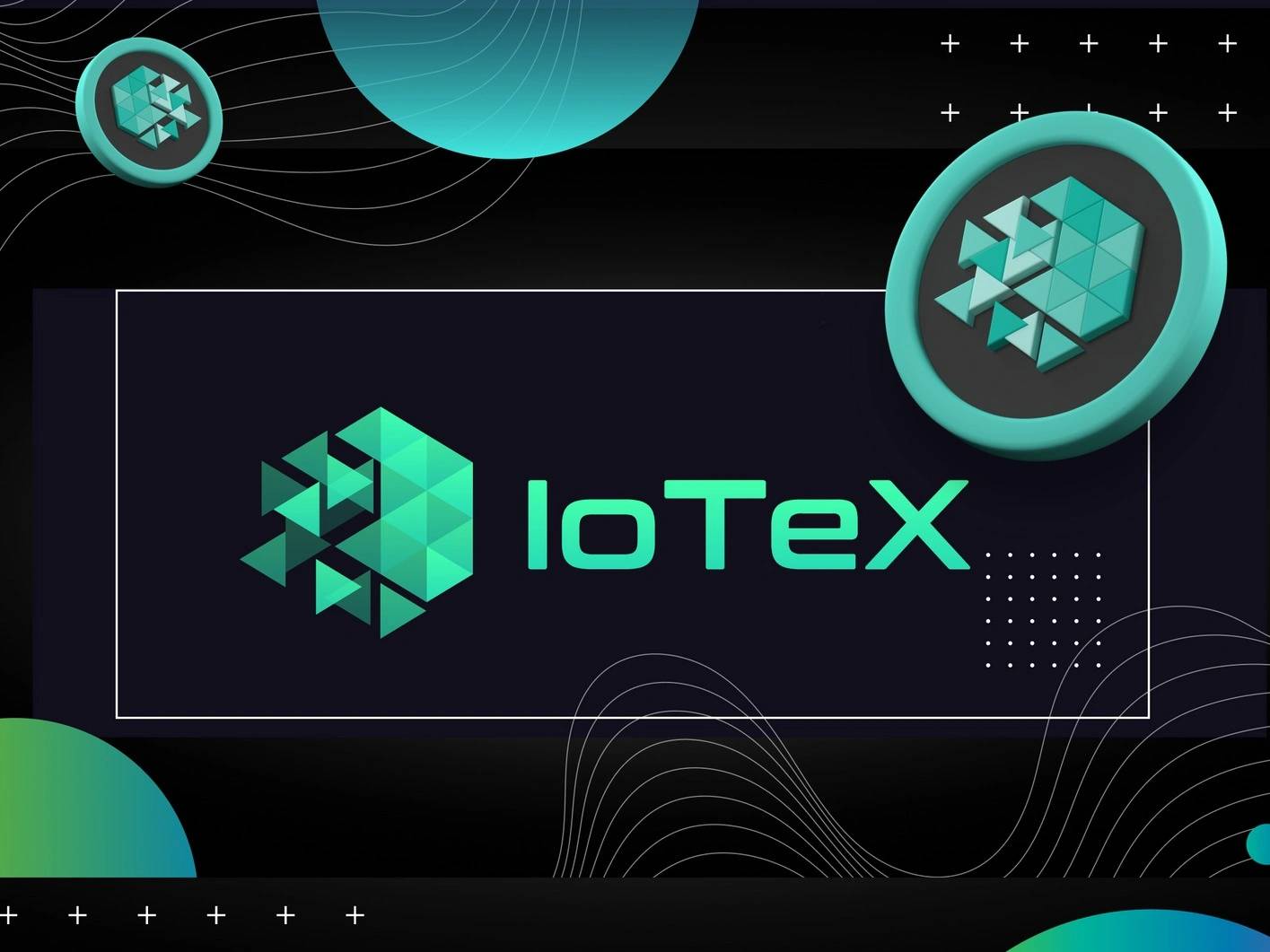IoTeX
IoTeX is a blockchain platform compatible with Ethereum and other major EVM chains, facilitated by its decentralized bridge. Additionally, W3bstream, IoTeX’s decentralized protocol, enables decentralized applications (dApps) to perform verifiable processing using zero-knowledge proofs, effectively connecting off-chain data sources with blockchain applications. [1]
Dr. Raullen Chai (CEO), Jing Sun (COO/CIO), Dr. Xinxin Fan (CTO), and Dr. Qevan Guo are the co-founders of IoTeX.
Overview
Launched in 2017, IoTeX aims to enhance the Internet of Things (IoT) by enabling devices and systems to work autonomously at scale. It differs from traditional blockchains as it is specifically designed for the challenges of the complex IoT landscape, addressing issues related to scalability, cost reduction, and privacy. Its blockchain-in-blockchain architecture involves a public root chain overseeing independent subchains, providing a hierarchical structure for handling diverse IoT devices efficiently. [2]
Privacy is a crucial consideration for IoTeX, which offers features like stealth addresses, ring signatures, and BulletProof to ensure built-in privacy-preserving transactions. This privacy-centric approach makes IoTeX suitable for various IoT ecosystems, including the sharing economy, smart homes, supply chain management, and device identity management. Developers and companies can create subchains tailored to specific IoT applications, connecting devices based on functionality, environmental context, or trust levels. [2]
IoTeX’s blockchain accommodates a diverse developer community, ranging from IoT hardware manufacturers to smart home app developers and autonomous car manufacturers. The sharing economy could benefit from IoTeX’s decentralized applications, such as pay-to-unlock for shared bikes. Additionally, IoTeX provides a secure and decentralized alternative to conventional private cloud infrastructures in smart home applications. IoTeX leverages developer tools, tokens, and user incentives to support growth within the evolving global token economy by empowering IoT companies to build ecosystems on its public chain. [2]
W3bStream
Developed by IoTeX, W3bstream operates as a decentralized protocol facilitating the connection between data originating in the physical world and the blockchain realm. The protocol utilizes a decentralized network of nodes that receive and process data from real-world “data publishers,” which may include devices, machines, or other sources. Subsequently, zero-knowledge proofs of real-world facts can be generated on this data, enabling their utilization by decentralized applications (dApps) across different Layer 1 (L1) and Layer 2 (L2) blockchains. [3]
Technology
ioTube
ioTube is a decentralized cross-chain bridge facilitating the two-way transfer of crypto-assets, including tokens and stablecoins, between IoTeX and other blockchain networks. Beyond its immediate use cases for introducing new assets, data, and liquidity to the IoTeX Network, ioTube has the potential to enhance IoTeX’s capabilities significantly. By leveraging ioTube to port essential crypto-assets and data, IoTeX could function as a backend processor for Ethereum (ETH) and other blockchains. [5]
In the long run, the unique assets generated by the IoTeX blockchain, such as data from IoT devices, can trigger logic in smart contracts on ETH and other blockchains, essentially serving as an oracle for non-IoTeX contracts or vice versa. ioTube consists of two key components: pre-deployed smart contracts on IoTeX and other blockchains and a pool of “witnesses” that monitors ioTube actions on these smart contracts. When a token-lock action occurs on one blockchain, the witness pool validates and relays the information to the other blockchain, where an equivalent amount of a “Proxy-Token” is minted. Conversely, when a Proxy-Token burn is detected, the witness pool validates and relays the information, unlocking the same amount of the original token on the other blockchain. [5]
Ucam
The Ucam is a blockchain-powered home security camera developed by IoTeX that restores data ownership to users and severs the link between a user’s Ucam identity and their internet identity, addressing prevalent privacy issues in home security cameras, mainly the Ring camera hacks of September 2019. However, it introduces considerable UI/UX challenges, particularly in key management, a major obstacle to widespread blockchain adoption. To address this, IoTeX devised a user-friendly one-click setup process, enabling individuals with no blockchain background to establish an IoTeX identity, including a public/private key pair, with just one click. [6]
The Ucam app offers users the convenience of managing multiple Ucams simultaneously, providing instant access to feeds on a unified home dashboard. Each Ucam supports customizable configurations, such as motion detection, which sends alerts and saves video clips when motion is detected. Additionally, Privacy Mode ensures that Ucam data is exclusively viewable on the owner’s mobile device. Authorizing access is simplified through QR code generation within the app and can be revoked anytime by toggling “Privacy Mode.” Ucam excels in real-time home monitoring, offering features like encrypted 1080p HD live stream, 360° coverage, photo and video capture, two-way audio communication, and night vision with up to 36 feet of visibility. Over-the-air firmware updates enable seamless integration of new features for Ucam users. [6]
Pebble Tracker
IoTeX’s Pebble is a Web3 smart tracker that addresses the needs of applications requiring robust data security, integrity protection, and multiparty trust throughout the supply chain. Current asset-tracking solutions lack essential security features, making them vulnerable to hacking and data corruption. Pebble captures real-world data to provide trusted information about events in real-time. Pebble is for blockchain users who can register their devices to the IoTeX MachineFi Portal, fund accounts, and engage with MachineFi DApps and games, reclaiming data ownership and earning rewards. [7]
Blockchain developers can leverage Pebble’s trusted data in smart contracts for MachineFi DApps or securely enforce business logic. Supply chain developers can utilize Pebble to establish a higher standard of trust in logistics and supply chain scenarios, benefiting from verifiable GPS, climate, motion, and light data. IoT developers seeking to prototype blockchain-based solutions can also create custom firmware for Pebble Tracker, utilizing a decentralized network for secure data verification and archiving, ready for integration into blockchain applications. [7]
MachineFi
Developed by IoTeX, MachineFi represents an intersection of machine and DeFi, aiming to capitalize on machine-generated data, events, and tasks in the Metaverse and Web3, presenting a significant economic opportunity. The main objective is to transition traditional IoT and machine sectors into decentralized MachineFi applications (Dapps), allowing users to engage in the machine economy. Developed over three years by the IoTeX team, MachineFi provides a robust foundation, facilitating real-time information and resource exchange among machines. It lets users monetize personal information and smart device data through IoTeX’s blockchain platform. [8]
MachineFi includes protocols like DeFi, SSI, DAO, NFT, and decentralized device management, offering developers tools to create machine-driven applications. Smart device owners can engage in machine-driven financial activities, earning cryptocurrencies by renting their devices for data collection, event monitoring, and task completion. [8]
IOTX Token
The IOTX coin is the native token of the IoTeX network. It serves multiple utilities to facilitate trusted and transparent interactions among various entities within the network, such as Delegates, stakeholders, product builders, service providers, and consumers. The IOTX coin creates economic and reputational incentives, ensuring the decentralized maintenance of the IoTeX Network and effective servicing of products bearing the “Powered by IoTeX” label. [9]
Tokenomics
The total supply of IOTX tokens was 9.7 billion as of August 2020. The allocation of IOTX tokens:
- Private Sale: 24% of total supply gradually throughout 2018-2019
- Community Reward Programs: 6% of total supply gradually over three years
- IoTeX Team: 15% of total supply from February 2019 and over the following four years
- Ecosystem: 30% of total supply gradually over three years
- Foundation: 25% of total supply gradually over three years

Burn-Drop
Burn-Drop represents a tokenomics design where 1 billion IOTX (10% of the total supply) will undergo burning as the first 1 million “Powered by IoTeX” devices are onboarded. Within this 1 billion IOTX, 90% will be permanently removed from circulation through burning, and the remaining 10% will be “dropped” (distributed to voters who auto-stake for ≥ 91 days). Smart contracts will facilitate burning 900 million IOTX (9% of the total supply) throughout the Burn-Drop program, effectively reducing the circulating supply. In comparison, 100 million IOTX (1% of the total supply) will be distributed. This automated process triggers a new Burn-Drop immediately after onboarding each new “Powered by IoTeX” device. [9]
Governance
The IoTeX Forum hosts governance discussions, and voting occurs on the IoTeX Governance Portal. Delegates propose new governance ideas, which undergo voting by token-holders. The IoTeX Foundation and core development entities implement the approved proposals. [10]
An IoTeX Improvement Proposal (IIP) serves as a design document, offering details to the IoTeX community about new features, processes, or environmental changes. IIPs are crucial in proposing and collecting community input on features and documenting the implemented design decisions within the IoTeX ecosystem. The revision history of IIPs, stored as text files in a versioned repository, serves as the historical record of the feature proposals. [11]
Halo Grant
The IoTeX Halo Grants Program, overseen by the IoTeX Foundation, aims to foster the expansion and advancement of the IoTeX ecosystem. This program encourages developers to create Dapps across domains, including DeFi, NFT, Gaming, Infrastructure/Developer Tooling, and DePIN (Decentralized Physical Infrastructure Networks). The updated Halo Grants Program comprises two primary initiatives: The Developer Grants and The Project Grants. [12]
- The Developer Grants, tailored for individual developers at different learning stages (Learner, Explorer, and Builder), ensure diverse contributions to IoTeX’s technology, ecosystem, and community.
- The Project Grants, targeted at experienced developers and teams, include the Integration Tier for projects transitioning Dapps or tools from other chains to IoTeX and the DePIN Incubator supporting projects with existing products or expertise, fostering the development of DePIN projects or integrating DePIN elements into their products. [12]
Notable Partnerships
Polygon
On August 13, 2023, IoTeX announced Polygon integration with W3bStream. With the integration of Polygon, these tools can now directly connect to the Polygon chain, tapping into its ecosystem. Similar to deploying a dApp on the IoTeX mainnet, on-chain proofs are sent to Polygon. This integration enables games to incorporate real-world data, from in-person play like Pokémon GO to geocached on-chain collectibles. DeFi applications can utilize real-world data, offering weather or traffic patterns futures. [14]
Arbitrum
In September 2023, W3bstream unveiled its latest integration with Arbitrum, offering dApp developers access to Arbitrum’s layer-2 scaling solution for Ethereum. Arbitrum's solution reduces the cost and congestion of Ethereum transactions, making it easier for dApp developers. With a growing ecosystem, Arbitrum supports various projects in categories from DeFi to the metaverse to gaming.
The integration with W3bstream allows developers in the Arbitrum ecosystem to enhance their dApps with real-world data. They can now incorporate on-chain events reflecting real-world assets, occurrences, and utilities, enabling innovative use cases in expanding sectors such as DePIN. [18]
Solana
In October 2023, W3bstream integrated with Solana. Solana developers gained access to W3bstream Studio, a graphical interface for managing real-world applications and their data. This platform includes an integrated development environment (IDE), project management tools, metrics dashboards, and event-handling capabilities. With the ability to transmit on-chain proofs to Solana, W3bstream applications could reach a broader user base. Solana’s scalable and interoperable ecosystem offered low costs and innovative features like compressed NFTs. [16]
Optimism
In November 2023, Optimism integrated IoTeX’s W3bStream, enabling developers to connect their decentralized applications (dApps) with real-world data, triggering on-chain events. This integration opened up possibilities across various sectors, such as fitness apps, green energy initiatives, and wireless 5G technology implementation. [15]
Conflux
On December 23, 2023, IoTeX integrated Conflux with W3bstream, offering DePIN founders building on Conflux access to W3bstream’s functionality as a middleware layer for the DePIN space. As China’s only regulatory-compliant public blockchain, this integration benefits DePIN projects and developers expanding into Asia. With the integration of Conflux, W3bstream’s tools directly connect to Conflux’s expanding ecosystem of applications and developers. Developers can seamlessly log into W3bstream Studio to craft real-world dApps and transmit on-chain proofs to Conflux. [17]
